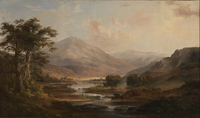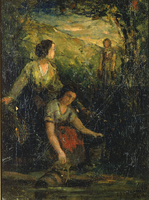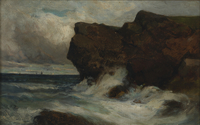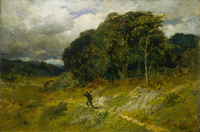Items
Tag
landscapes
-
 Romantic Landscape
Romantic Landscape -
 Scottish Landscape Robert S. Duncanson made several trips to Scotland, probably inspired by his father's Scottish heritage. He created romantic wilderness views that may have been influenced by the novels and poems of Sir Walter Scott. In this piece the warm colors and rich vegetation make a remote scene appear welcoming, and would have appealed to the sentimental tastes of his American patrons.
Scottish Landscape Robert S. Duncanson made several trips to Scotland, probably inspired by his father's Scottish heritage. He created romantic wilderness views that may have been influenced by the novels and poems of Sir Walter Scott. In this piece the warm colors and rich vegetation make a remote scene appear welcoming, and would have appealed to the sentimental tastes of his American patrons. -
 The Drinking Pool (three women at the water)
The Drinking Pool (three women at the water) -
 Ocean Cliffs
Ocean Cliffs -
 Approaching Storm This windy scene of a lone figure struggling in the face of a storm would have held special meaning for nineteenth-century viewers, who believed that their nation's landscape was infused with God's presence. In 1886, the year he painted Approaching Storm, Edward Mitchell Bannister wrote an essay titled "The Artist and His Critics," in which he argued that spiritual expression is the artist's ultimate goal. (Hartigan, Sharing Traditions, 1985)
Approaching Storm This windy scene of a lone figure struggling in the face of a storm would have held special meaning for nineteenth-century viewers, who believed that their nation's landscape was infused with God's presence. In 1886, the year he painted Approaching Storm, Edward Mitchell Bannister wrote an essay titled "The Artist and His Critics," in which he argued that spiritual expression is the artist's ultimate goal. (Hartigan, Sharing Traditions, 1985) -
 Boat on Sea The sea was a favorite subject for Edward Mitchell Bannister, who had worked as a cook on a trading ship. In this peaceful view of Rhode Island’s Narragansett Bay, a popular subject for nineteenth-century American artists, he focused attention on the brilliant coastal light. Bannister was a deeply religious man who shared with many Americans of his time a belief that nature was an expression of God’s presence. In this scene the radiant light illuminates the bay to suggest a divine blessing. (Narratives of African American Art and Identity: The David C. Driskell Collection, 1998)
Boat on Sea The sea was a favorite subject for Edward Mitchell Bannister, who had worked as a cook on a trading ship. In this peaceful view of Rhode Island’s Narragansett Bay, a popular subject for nineteenth-century American artists, he focused attention on the brilliant coastal light. Bannister was a deeply religious man who shared with many Americans of his time a belief that nature was an expression of God’s presence. In this scene the radiant light illuminates the bay to suggest a divine blessing. (Narratives of African American Art and Identity: The David C. Driskell Collection, 1998) -
 Edward Mitchell Bannister Edward Mitchell Bannister became one of the first African American painters to gain national recognition when his landscape Under the Oaks won a first prize at the Centennial Exposition in Philadelphia (1876). Almost entirely self-taught, Bannister began his career in the 1850s in Boston, where he enjoyed the patronage of that city's substantial black community. He was also a committed abolitionist who continued to advocate for African American rights after the Civil War. When Bannister settled in Providence, Rhode Island, in 1869, his reputation grew as his landscapes and coastal views were exhibited more widely. His name proved unfamiliar, however, to the Centennial Exposition judges, who tried to withhold his prize upon discovering that he was African American. When the other artists threatened to withdraw from the competition if Bannister was denied his medal, the original award was upheld.
Edward Mitchell Bannister Edward Mitchell Bannister became one of the first African American painters to gain national recognition when his landscape Under the Oaks won a first prize at the Centennial Exposition in Philadelphia (1876). Almost entirely self-taught, Bannister began his career in the 1850s in Boston, where he enjoyed the patronage of that city's substantial black community. He was also a committed abolitionist who continued to advocate for African American rights after the Civil War. When Bannister settled in Providence, Rhode Island, in 1869, his reputation grew as his landscapes and coastal views were exhibited more widely. His name proved unfamiliar, however, to the Centennial Exposition judges, who tried to withhold his prize upon discovering that he was African American. When the other artists threatened to withdraw from the competition if Bannister was denied his medal, the original award was upheld.